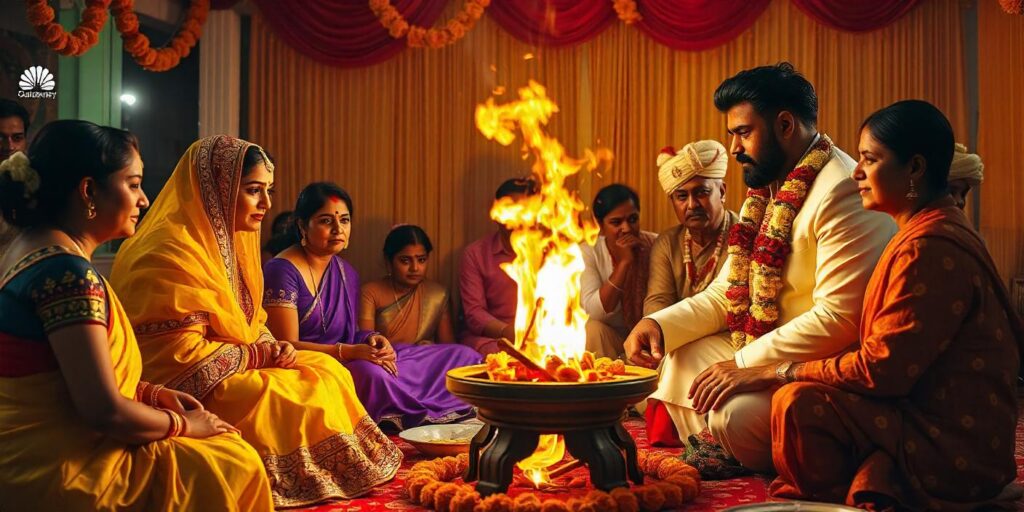The concept of Kanyadaan in Hindu Marriage is deeply rooted in the traditions of Hindu marriage. Derived from Sanskrit, “kanya” means “girl or bride,” and “daan” translates to “gift.” Together, kanyadaan means gifting one’s daughter to the groom during a wedding. This ritual, considered one of the most sacred and auspicious acts in Hindu marriage traditions, symbolizes the transfer of parental responsibilities to the groom. Let’s explore the kanyadaan ritual in full detail, highlighting its significance, procedures, and evolving meaning in modern times.
Importance of Kanyadaan in Hindu Marriage
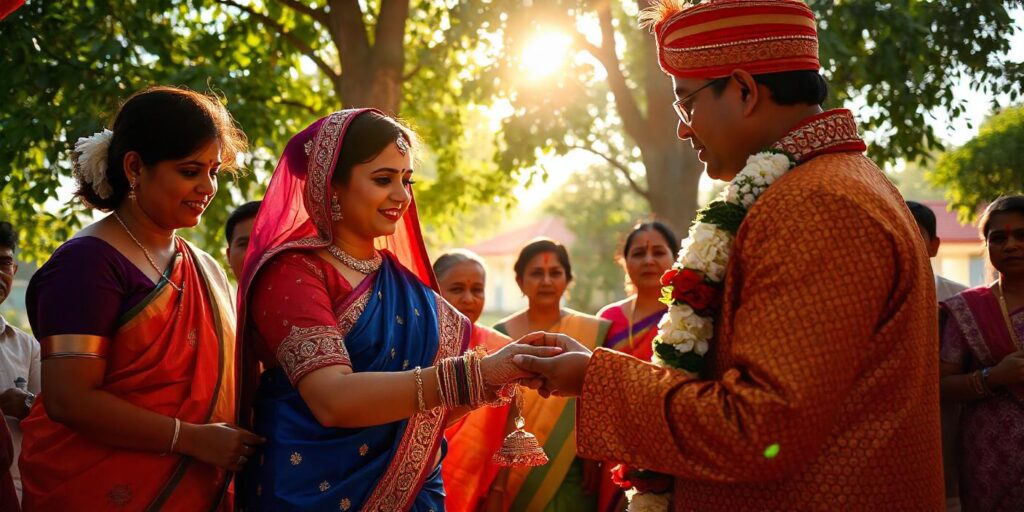
Kanyadaan in Hindu Marriage, a sacred ritual, is one of the most integral parts of Hindu marriage traditions. The term “Kanyadaan” combines two Sanskrit words: ‘Kanya’ (daughter) and ‘Daan’ (donation), meaning the giving away of a daughter to her husband. This ritual not only symbolizes the transfer of responsibility but also holds immense spiritual, cultural, and emotional significance in Hinduism.
Let’s delve deeper into the importance of Kanyadaan in Hindu marriage, its spiritual value, and the emotional essence it carries.
1. Spiritual Significance of Kanyadaan
The Kanyadaan ritual is considered the highest form of charity, often referred to as “Mahadaan” in the Vedas. Here’s why:
- Cleansing of Sins: It is believed that by performing Kanyadaan in Hindu Marriage, the bride’s parents can atone for their past deeds and sins, ensuring spiritual growth.
- Divine Connection: In Hindu scriptures, the groom is regarded as an incarnation of Lord Vishnu, and the bride as Goddess Lakshmi. By offering their daughter, parents symbolically unite Vishnu and Lakshmi, bringing blessings to both families.
- Sacred Bond Creation: The ritual not only unites two individuals but also strengthens the bond between their families, fostering a harmonious union.
2. Cultural Importance in Hindu Marriage Traditions
Kanyadaan holds an irreplaceable position in the rich tapestry of Hindu marriage traditions.
- Passing Responsibility: The father transfers his responsibilities to the groom, entrusting him to care for his daughter for life.
- Symbol of Trust: This act is a demonstration of the bride’s parents’ faith in the groom’s ability to provide love, respect, and security to their daughter.
- Fostering Family Ties: The ritual marks the joining of two families, encouraging unity and mutual respect.
3. Emotional Essence of Kanyadaan
The Kanyadaan ritual is as emotional as it is sacred.
- Bittersweet Transition: For parents, it signifies both pride and a sense of loss as they give away their beloved daughter to another family.
- A Father’s Love: The act of placing his daughter’s hand into the groom’s hand symbolizes the father’s unconditional love and trust in the new journey his daughter is about to embark upon.
- Shared Contributions: The mother participates by pouring holy water, signifying her blessings and emotional support.
4. Religious Perspective of Kanyadaan in Marriage
According to Hindu texts like the Manu Smriti, a woman must be protected by her father before marriage and by her husband after marriage.
- Guardian Shift: Kanyadaan reflects this transfer of guardianship from the father to the husband.
- Ritual Purity: The ceremony, accompanied by sacred chants and offerings, ensures a pure and auspicious beginning for the bride and groom.
5. The Role of Kanyadaan in Modern Hindu Marriages
While the essence of Kanyadaan in Hindu Marriage remains intact, its execution has evolved over time.
- Equal Participation: Today, both parents often perform the ritual, reflecting modern values of equality.
- Maintaining Traditions: Despite changing times, Kanyadaan continues to be a deeply cherished aspect of Hindu marriage traditions, bridging the past with the present.
How Is the Kanyadaan Ritual Performed?
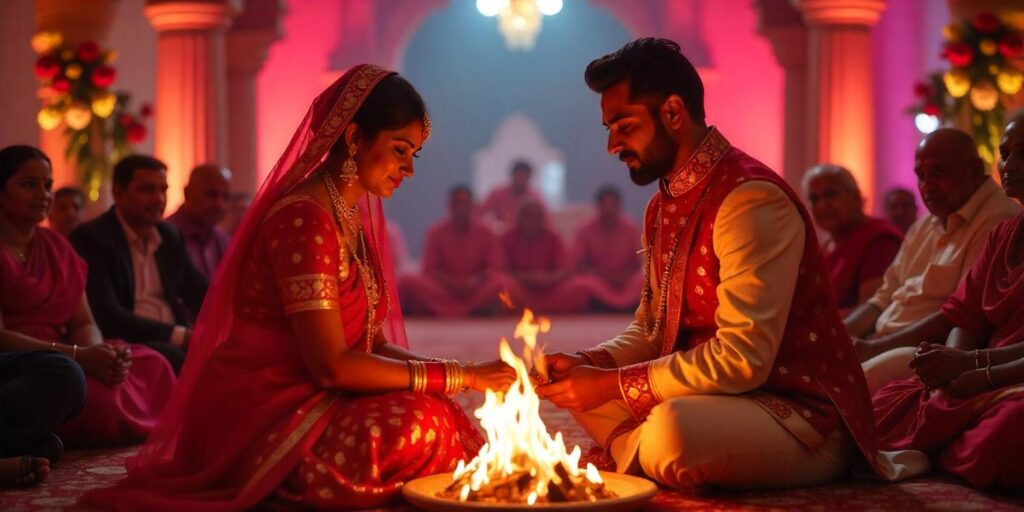
The Kanyadaan ritual is one of the most sacred and cherished parts of the Hindu marriage ceremony. It is a symbolic and spiritual process through which the bride’s parents, particularly the father, hand over their beloved daughter to the groom. This ritual follows a structured and meaningful process, overseen by a priest and accompanied by sacred mantras. Below is a detailed explanation of the steps involved in performing the Kanyadaan ritual, with a focus on its spiritual and cultural significance.
1. Observing a Fast
The Kanyadaan ritual begins with the father of the bride observing a fast.
- Significance of Fasting: The fast symbolizes devotion, purity, and the sanctity of the occasion. By refraining from food, the father demonstrates his spiritual dedication and willingness to ensure the successful union of his daughter and her groom.
- Spiritual Preparation: It is believed that fasting purifies the mind and body, allowing the father to perform the Kanyadaan ritual with utmost sincerity and reverence.
2. Placing the Bride’s Hand Over the Groom’s (Hastamelap)
A central part of the Kanyadaan in marriage is the symbolic transfer of responsibility.
- Hastamelap: The bride’s father places her hand in the groom’s hand, representing the transfer of his duties and responsibilities toward his daughter to the groom.
- Symbolism: This act signifies trust in the groom and his commitment to care for and cherish the bride throughout their married life.
- Blessings from the Elders: Often, elders bless the couple during this moment, ensuring a prosperous and harmonious marital journey.
3. Holy Water Ritual
The use of holy water adds a divine touch to the Kanyadaan ritual.
- Role of the Mother: The bride’s mother pours holy water over her daughter’s hand, allowing it to flow into the groom’s hand.
- Symbolism of Water Flow: This act signifies the parents’ joint effort and willingness to give away their daughter in marriage. It also represents the seamless transition of responsibility from the bride’s parents to the groom.
- Spiritual Connection: Holy water is considered purifying, invoking blessings from the deities for the couple’s married life.
4. Chanting Vedic Mantras
Chanting mantras is an essential aspect of the Kanyadaan ritual in Hindu marriage traditions.
- Priest’s Role: The priest recites Vedic hymns and mantras, calling upon divine blessings for the bride and groom.
- Sanctifying the Union: These mantras purify the atmosphere and sanctify the sacred bond being formed.
- Groom’s Vows: During this phase, the groom takes solemn vows to protect, respect, and cherish the bride throughout their married life, reinforcing the sanctity of the Kanyadaan in marriage.
5. Offering Sacred Items
The offering of sacred items symbolizes prosperity, unity, and good fortune for the couple.
- Traditional Offerings: Items such as rice, betel nuts, coins, and flowers are placed in the hands of the bride and groom.
- Symbolic Meaning:
- Rice: Represents fertility and prosperity.
- Betel Nuts: Symbolize longevity and strength.
- Coins: Denote financial stability and wealth.
- Flowers: Reflect beauty, love, and harmony in their marital life.
- Cultural Significance: These offerings are not merely symbolic; they carry the prayers and blessings of the bride’s family for a happy and fulfilling marriage.
6. Taking Vows
The final step in the Kanyadaan ritual is the taking of vows, which cements the spiritual and emotional bond between the couple.
- Mutual Promises: Both the bride and groom make promises to honor, love, and respect each other, ensuring a lifelong partnership based on trust and understanding.
- Commitment to Harmony: These vows are a testament to their commitment to support each other through life’s ups and downs.
- Blessings from the Divine: With the priest’s guidance, these vows are witnessed by the divine, making the union sacred and eternal.
Evolution of Kanyadaan Over Time

In ancient times, kanyadaan in Hindu marriage was seen as the father’s duty to ensure his daughter’s happiness and security. However, with changing societal norms, the ritual has evolved:
- Modern Interpretations: While the essence of kanyadaan remains intact, it is now seen as a mutual acceptance of responsibilities by both families.
- Empowerment of the Bride: The focus has shifted from “giving away” the bride to celebrating her choices and individuality.
- Inclusivity: In some cases, mothers or other family members also perform the ritual, reflecting changing family dynamics.
Symbolism of Kanyadaan in Hindu Marriage Traditions
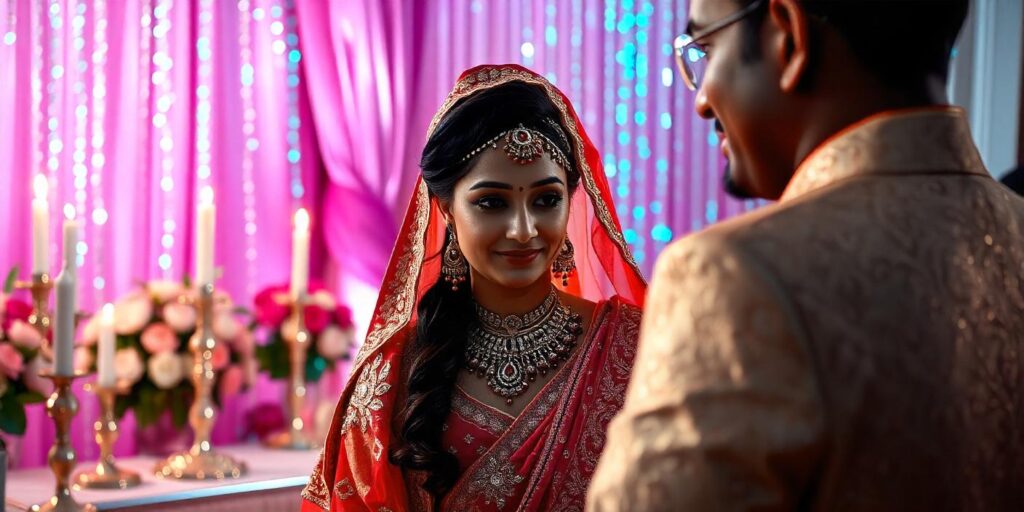
Kanyadaan is more than just a ritual—it is a symbolic act that reflects the values of love, respect, and harmony in Hindu marriage traditions. Some key symbolic aspects include:
- The Bride as Lakshmi: Representing prosperity and happiness, the bride is seen as the Lakshmi of the household.
- The Groom as Vishnu: Seen as the protector and guide, the groom is entrusted with the bride’s well-being.
- Union of Families: The act of kanyadaan symbolizes the union of two families, fostering mutual respect and cooperation.
Why Is Kanyadaan Considered Mahadaan?
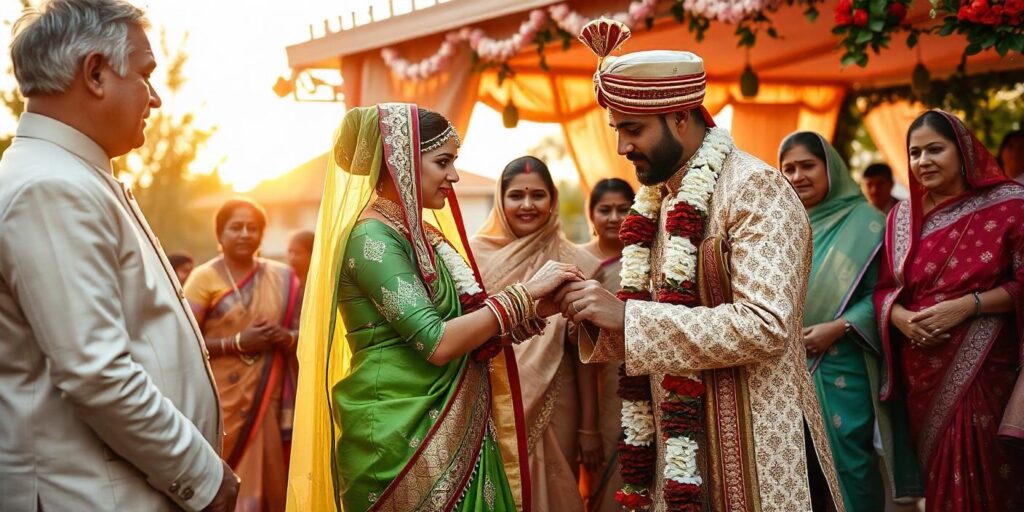
In the hierarchy of Hindu marriage rituals, Kanyadaan holds a unique and revered position, often referred to as “Mahadaan”, meaning the greatest gift. This sacred act is considered one of the most significant components of a Hindu marriage, carrying immense spiritual, emotional, and cultural importance. The profound meaning and significance of Kanyadaan in marriage have made it a cornerstone of Hindu marriage traditions. Below, we explore why Kanyadaan is regarded as Mahadaan, its symbolism, and its cultural value.
- Spiritual Significance: It is believed that the parents achieve salvation (moksha) by performing kanyadaan.
- Emotional Value: The act represents the ultimate sacrifice of parents, who entrust their beloved daughter to another family.
- Cultural Importance: Kanyadaan in marriage is a cornerstone of Hindu marriage traditions, emphasizing duty, virtue, and family values.
Key Highlights of the Kanyadaan Ritual
1. Kanyadaan Ritual Steps
The Kanyadaan ritual is a structured process, rich in symbolism and spiritual significance.
- Observing a Fast: The bride’s father often observes a fast, signifying purity and devotion.
- Holy Water Ceremony: The bride’s mother pours holy water over her daughter’s hand, transferring the responsibility to the groom.
- Chanting Mantras: The priest recites Vedic hymns, sanctifying the union and invoking blessings from deities.
- Offering Sacred Items: Items like rice, betel nuts, coins, and flowers are offered, symbolizing prosperity and harmony in the couple’s new life.
Astrology Product: Kubersukh
2. Kanyadaan in Marriage
- Bride’s Transition: Kanyadaan marks the bride’s transition from her parental home to her new family.
- Commitment of the Groom: During this ritual, the groom vows to cherish, protect, and respect the bride, reinforcing the sacredness of the union.
3. Significance in Hindu Marriage Traditions
- Sacred Union: In Hindu marriage traditions, Kanyadaan celebrates the union of not just two individuals but also two families.
- Virtuous Act: The ritual is considered an act of virtue, reflecting the parents’ commitment to their dharma and their daughter’s well-being.
Why Mahadaan? A Deeper Insight

The term “Mahadaan” encapsulates the unparalleled importance of Kanyadaan in Hindu culture. Below are some key reasons why it is considered the greatest gift:
1. A Divine Act
- Comparison to Charity: While giving material possessions is seen as virtuous, offering one’s daughter in marriage is viewed as the ultimate charitable act, as it involves immense emotional and spiritual commitment.
- Earning Divine Blessings: The parents performing Kanyadaan are believed to earn blessings from the divine, ensuring prosperity and spiritual elevation for their family.
2. Elevating the Daughter’s Life
- New Chapter: Through Kanyadaan, parents enable their daughter to embark on a new phase of life, filled with love, respect, and shared responsibilities.
- Ensuring Happiness: The act signifies the parents’ hope and prayers for their daughter’s happiness and success in her married life.

3. Celebrating Dharma and Family Bonds
- Fulfilling Responsibilities: Kanyadaan in Hindu marriage is considered a way for parents to fulfill their moral and spiritual responsibilities toward their daughter.
- Strengthening Family Ties: The ritual strengthens familial bonds, symbolizing unity, harmony, and mutual respect between the bride’s and groom’s families.
Conclusion
The act of Kanyadaan in Hindu marriage is a deeply revered ritual, embodying tradition, spirituality, and emotional depth. Rooted in ancient scriptures, Kanyadaan holds immense significance as a cornerstone of Hindu marriage traditions, symbolizing the ultimate parental duty and the sanctity of family bonds. Whether in traditional or modern settings, Kanyadaan in marriage continues to reflect the values of love, trust, and responsibility. By honoring and preserving this sacred Kanyadaan ritual, we pay homage to the cultural richness and spiritual essence of Hindu marriages, ensuring that this timeless tradition remains a guiding light for generations to come.

